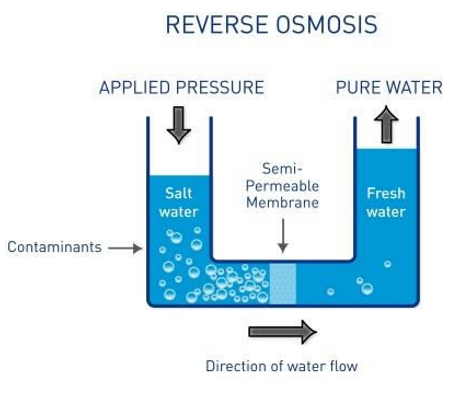Desalination:
-
Desalination is the process of removing salts from water to produce water that meets the quality (salinity) requirements of different human uses.
-
Most commonly used technology for the process is reverse osmosis.
Desalination Process:
-
An external pressure is applied to push solvents from an area of high-solute concentration to an area of low-solute concentration through a semi-permeable membrane.
-
The microscopic pores in the membranes allow water molecules through but leave salt and most other impurities behind, releasing clean water from the other side.
-
These plants are mostly set up in areas that have access to sea water.

Advantage of Desalination Plants:
-
It can extend water supplies beyond what is available from the hydrological cycle, providing an “unlimited”, climate-independent and steady supply of high-quality water.
-
It can provide drinking water in areas where no natural supply of potable water exists.
-
As it generally meets or exceeds standards for water quality, water desalination plants can also reduce pressure on freshwater supplies that come from areas (over exploited water resources) that need protecting.
Disadvantage of Desalination Plants:
-
Costly to build and operate desalination plants as the plants require huge amounts of energy.
-
Energy costs account for one-third to one-half of the total cost of producing desalinated water. Because energy is such a large portion of the total cost, the cost is also greatly affected by changes in the price of energy.
-
The environmental impact is another disadvantage to water desalination plants. Disposal of the salt removed from the water is a major issue. This discharge, known as brine, can change the salinity and lower the amount of oxygen (Hypoxia) in the water at the disposal site, stressing or killing animals not used to the higher levels of salt.
-
In addition, the desalination process uses or produces numerous chemicals including chlorine, carbon dioxide, hydrochloric acid and anti-scalents that can be harmful in high concentrations.
Opportunities: The environmental problem can be changed into an economic opportunity as:
-
The discharge (brine) can also contain precious elements like uranium, strontium as well as sodium and magnesium which have the potential to be mined.
-
Brine has been used for aquaculture, with increases in fish biomass of 300%. It has also been successfully used to cultivate the dietary supplement Spirulina, and to irrigate forage shrubs and crops.
Use of Desalination Plants in India:
-
It has largely been limited to countries in the Middle East and has recently started being used in parts of the United States and Australia.
-
In India, Tamil Nadu has been the pioneer in using this technology, setting up two desalination plants near Chennai in 2010 and then 2013.
-
The other states that have proposed these plants are Gujarat and Andhra Pradesh.
Way Forward
-
There is a need to make desalination technologies more affordable, i.e. increasing the viability of desalination for addressing Sustainable Development Goal 6 (SDG-6: Ensure Access to water and Sanitation for All).
-
To do this, technological refinement for low environmental impacts and economic costs, along with innovative financial mechanisms to support the sustainability of desalination schemes, will likely be required.